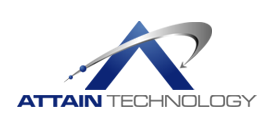Bob Paradise, Founder of Attain Technology, Date: 9-10-25
Human vs. Machine: Where AI Works Best (and Where It Doesn’t)
AI is everywhere right now. Business leaders are being told it can save time, boost profits, and even solve world hunger… okay we made up the last part. But the truth is, AI can do incredible things, and we are seeing it explode in strength and popularity in ways we haven’t seen before. In just 2 months after it’s public release, ChatGPT alone garnered over 100 million users, making it the fastest growing consumer application of all time. And it’s estimated that 800 MILLION people are using it weekly (demandsage). What people have been able to do with AI has been fascinating to see, and the possibilities are seemingly endless.
However… it’s not all magic, it makes mistakes… many mistakes.
You see, AI is still hallucinating… wait what? Hallucinating?
Yes, hallucinating. AI has the tendency to generate information that looks and sounds correct but is completely made up. For example, it might invent a statistic, misquote a source, or confidently provide an answer that has no factual basis. To a casual reader, it feels believable — but it’s not real. This is one of the biggest risks of relying on AI without human oversight. If you don’t catch these errors, the consequences can be costly.
That’s why understanding both the strengths and shortcomings of AI is so important. It’s a powerful tool that can transform the way businesses work, but only if leaders know where to trust it, where to double-check it, and where human judgment must stay firmly in control.
AI’s Strength in Repetition and Scale
One of AI’s greatest strengths is its ability to handle massive amounts of data quickly and without getting tired. It can scan documents, monitor systems, and run calculations in seconds. For example, AI tools in construction can automatically detect errors in blueprints, while in manufacturing they can spot defects on a production line long before a human eye would notice. That speed and scale can save businesses time, money, and frustration.
But efficiency alone isn’t the full picture. AI doesn’t ask “why” — it simply processes what it’s given. That’s fine when the task is routine, but when the stakes are higher, it needs human oversight.
Context is Still Key
Humans bring something AI cannot replicate: context. When negotiating with a client, making a tough hiring decision, or handling a crisis, people rely on intuition, empathy, and life experience. Those qualities aren’t programmable. AI can analyze the words in an email, but it can’t sense tone the way a manager does when they know their team is stressed.
This is where business leaders often go wrong with AI. They assume that because it’s smart with numbers and patterns, it’s also smart with people. But leadership, creativity, and emotional intelligence are areas where humans will always outperform machines.
The Myth of AI as a Replacement
There’s a lot of fear that AI is coming for jobs. The reality is more nuanced. AI doesn’t replace people — it replaces tasks. It can draft an email, summarize a report, or create a project timeline, but it doesn’t have the ability to build relationships, rally a team, or innovate new solutions.
The real risk isn’t AI taking over. It’s businesses that treat AI as a total replacement and lose the human touch that makes them competitive. Clients don’t want to deal with a chatbot when a problem arises; they want a real person who understands their unique situation.
So if you’re thinking of firing your secretary in favor of ChatGPT, you may want to think twice…
Let’s Go Back to Hallucinating…
One of the biggest risks in relying too heavily on AI is something called a “hallucination.” This is when the system generates content that sounds correct but is actually false. For example, an AI tool might create a report that cites a statistic or a study — only for that study to not exist at all. To the untrained eye, it looks convincing, but it’s made up.
This happens because AI doesn’t “know” facts the way humans do. It predicts patterns in language based on the data it has seen, and sometimes it fills in the gaps incorrectly.
To give this a human example, think of it like this:
You have a butler, and you ask the butler to “bring me a glass of water with lemon in it”.
The butler would bring you a glass of water with lemon juice squeezed in it and the slice of lemon on the glass… like any normal butler would.
Now, let’s say you have an AI butler, and you ask it the same thing.
The AI butler may bring you the right order sometimes, but other times, it may bring you a glass of water with a whole lemon (unpeeled) floating in it. Other times it may bring you lemonade.
That’s how AI hallucinations work. The response looks close enough to what you asked for that it feels right, but it’s not actually what you wanted or needed. And in business, those kinds of “off” answers can lead to wasted time, lost money, or even bad decisions if no one catches them.
The real winning combo is having both.
The real power comes from humans and AI working together. Think of AI as the tool that removes the heavy lifting, leaving people free to focus on higher-value work. AI can flag trends in production data, and humans can decide whether to scale operations up or down. AI can monitor cybersecurity threats around the clock, but humans decide how to respond when an incident happens.
When both sides play to their strengths, businesses see the biggest gains. AI doesn’t replace decision-making — it supports it. The companies that understand this balance will be the ones who gain a competitive edge.
So What Does This All Mean?
AI is not going away, and neither are the risks that come with it. For business leaders, the question isn’t if you should adopt AI, but how. Do you let it run unchecked, or do you set clear boundaries? Do you treat it as the answer to every problem, or as one of many tools in your toolbox?
The companies that succeed will be the ones that strike the right balance. They’ll use AI to drive efficiency and uncover insights, but they’ll keep humans in control where judgment, creativity, and trust are required. They’ll also recognize the dangers of AI hallucinations and put safeguards in place, so mistakes don’t spiral into costly problems.
If you’re unsure where AI fits in your business, you don’t have to figure it out alone.
Let’s Figure It Out For Your Business… Together
Attain Technology can help you cut through the hype and discover where AI truly adds value — without losing the human judgment your business depends on. Book an AI Consulting and Strategy Meeting with our team to explore how AI can improve productivity, reduce risks, and strengthen decision-making in your organization.
➡️ Book Your AI Strategy Meeting Today
About Attain Technology
Attain Technology has been helping businesses across New England simplify technology for over 18 years. We’re more than just an IT provider — we’re a trusted partner that guides companies through the challenges of modern tech. From cybersecurity and cloud services to AI consulting and digital strategy, our team works side by side with business leaders to keep operations secure, productive, and future-ready. As AI continues to reshape the business world, Attain Technology serves as your guide to adopting these tools safely and effectively, while ensuring you always have the reliable IT foundation you need to grow.


